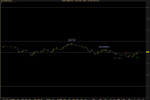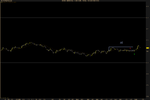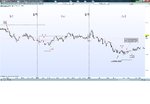Hey guys,
I am putting together a list of checks and general rules of thumb to try to keep me on the right side of the market during ranges. And to help identify where valid trades might develop early on so I don't miss them. I've been doing it for a couple weeks and I haven't had nearly as many situations where I missed a setup developing. These are my checks for ranging markets.
1. Check nearby price levels first
2. Look for continuation until pressure evens out or there is a giant reversal pattern, then either direction is fair game
3. Watch for retracement
4. Wait for economical entry point, then wait for squeeze
Explanation:
-Check the 20 and round # levels first, not the other way around (ex: I used to look for setups, and then check the location to see if there was a 20 level or round # blocking or supporting it. Now, I check the nearby price levels first. That way if a 20 level is holding, I know that I should be on the lookout for a setup. Or if price is under a 50 level, I know its going to need a powerful setup to crack it. Then when I see a weak BB or something, I'm not tempted to jump in prematurely just because I saw a box develop.
-Continuation: The first thing I look for when a range starts is a continuation trade. Ex, if price was bullilsh before the range, I look for bullish continuation. Specifically, I look for price to hold at a 20 level or a round # at the bottom of the range. I do not look for a bearish entry unless I see a large reversal pattern followed by a setup, OR the range lasts for a long time to the point where the pressure is even. At that point I will consider a bullish or bearish entry. I would not consider myself to be biased towards continuation, more just reading pressure, because as soon as the pressure becomes even, I switch to neutral.
-Avoid trading against 50% price retracements. This is my personal preference right now. If price had the support of a 20 or 50 level, I might take a chance and just trail sharply, but until I make a bit more progress I will treat these as aggressive setups and avoid them.
For the setup itself, if conditions line up, the only real necessary ingredients are a fairly obvious barrier level and the squeeze. If the entry isn't economical I skip it. Squeeze is a little weird to me right now, because it's different identifying it in real time than looking back through a bunch of charts that aren't moving.
This seems to be helping me find points where setups are likely to develop. I used to not see IRBs until it was a little too late and then I hesitated to enter. I am basically following conditions first, and the setup doesn't have to look as perfect. As long as it provides a good entry and squeeze, I pay more attention to determining who is winning overall, and the setup is just the signal to enter. Sometimes the setups this week looked a little messy but if they have all of the ingredients, I think they're still valid. It honestly feels a little weird at first, like I'm operating on a hunch, but I really don't think it is. I think some of us have been basing the probability of a trade working out on the clarity of the box setup itself, when it should be based on the clarity of the overall pressure, what levels are holding in the market, etc... When we think in terms of bears exiting/bulls entering, I am trying to switch to evaluating that on the whole screen, not the setup (unless it's a really lengthy setup), because that's only going to affect short timeframe scalpers like us. That's a really hard switch actually, and it will probably feel weird for me for awhile. It sounds kind of stupid, but a lot of people, like me, are visual learners first. Which explains why a month ago I kept taking BBs in bad places around the chart. Beautiful looking BBs with no real conditional support.


















